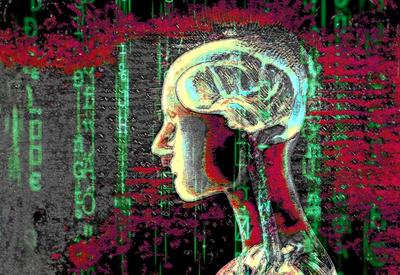Should the constraints of the human brain inform how we design artificial intelligence? In this essay, Danyal Akarca explores how our growing understanding of neuroscience is inspiring new paradigms at the forefront of AI research following his recent publication in Nature Machine Intelligence.
It is now over a century since the father of modern neuroscience, Ramón y Cajal, proposed that animal nervous systems are organised according to three very general principles: material, space and time. These principles tell us that animal brains conserve their material to prevent unnecessary energy expenditure, space to optimise the physical arrangement of cells within a finite volume, and time to enable rapid and effective communication that facilitate action.
Understanding general principles like these within neuroscience gives us context for how, in living organisms existing in the animal kingdom, various flavours of biological intelligence can evolve and develop. Of course, these are not the only principles at play – neuroscience has advanced tremendously the last hundred years – but such principles are useful because they sharpen our understanding of the various physical factors that commonly constrain the emergence of intelligent behaviour in biology. But can principles of brain organisation and function, such as these proposed by Cajal, inspire new advances at the forefront of artificial intelligence (AI)?
___
Under certain conditions, evolution will also construct efficient, economical and energetically resourceful systems of behaviour.
___
To answer this question, it is first useful to recognise that there is actually deep insight to be gathered by thinking about why such principles may exist at all in the natural world. As you may expect, the core explanation invokes evolution. Evolutionary forces construct organisms that contain many complex interacting internal systems that together control intelligent behaviour. This alone is a truly awe-inspiring and miraculous feat of nature. But evolution doesn’t just do that. Under certain conditions, evolution will also construct efficient, economical and energetically resourceful systems of behaviour. This is for the simple reason that survival – the main driver of change over evolutionary timescales – is best served by organisms appropriately using energy in terms of where, when and how it is stored, mobilised and deployed.
 SUGGESTED READING
Do no harm: AI and medical racism
By Arshin Adib-Moghaddam
SUGGESTED READING
Do no harm: AI and medical racism
By Arshin Adib-Moghaddam
Evolution will therefore often find highly efficient solutions to some of the most complex problems that we care about in agents capable of intelligence – from learning and memory to value assignment and decision making. This means that Cajal’s principles of material, space and time can each really be thought of as derivative biological quantities that have been optimised gradually over time, through evolutionary pressures, because they confer advantage.
The competitive nature of evolution drives intelligent systems and agents to be efficient by solving problems in highly elegant (and often unpredictable) ways. Biological systems, like the brain, are ultimately influenced by a balance between the energetic costs incurred by their operation and the benefits realised by energy expenditure. This basic fact is not really reflected in modern AI models.
So, evolution shapes systems that are capable of solving competing problems that are both internal (e.g., how to expend energy) and external (e.g., how to act to survive), but in a way that can be highly efficient, in many cases elegant, and often surprising. But how does this evolutionary story of biological intelligence contrast with the current paradigm of AI?





















Join the conversation